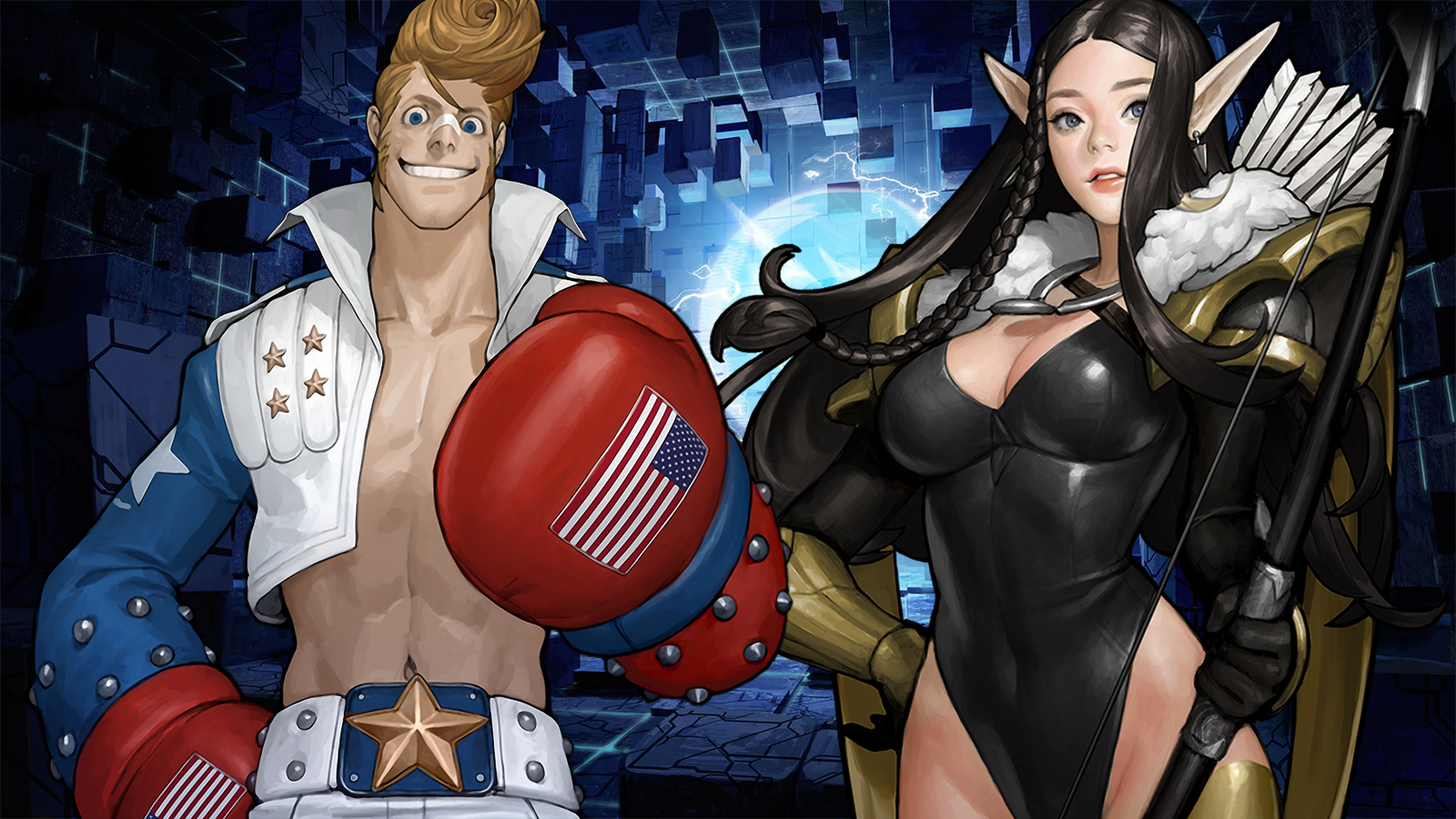If Street Fighter were a MOBA, it'd look like this
Our thoughts on Hyper Universe, a 2D take on the MOBA complete with towers and 4v4 melee.

Hyper Universe is a side-scrolling action game that was presumably orphaned at birth and raised by a pack of MOBAs. At least, that would explain its MOBA trappings. It has minions to last-hit, towers and lanes to defend, and items and skills to upgrade. But it is still a 2D action game, so the usual left, middle and right lanes have become five vertically stacked lanes. It’s a fun mashup that makes for fast fights and short games, but Hyper Universe’s fewer dimensions also significantly limit its replayability and strategic depth.
Intrigued by its heritage, I dive in and promptly run into an endless loading screen. Off to a flying start, aren’t we? But then, that’s tradition for Early Access games. I manage to sort that out and start the game proper, and I’m treated to a gorgeous anime intro. In fact, all of Hyper Universe is pretty. Heroes (or Hypers) are stylish, with smooth animations. I tear through the prologue’s enemies as Allen, a boy wonder with a sword in one hand and lightning in the other.
The genre combination is novel.
By default, you move with the arrow keys and use abilities with Q through R and A through F, which is pretty awkward. I plug in my gamepad and things start to click. I’ve got my basic attack, special attack, dodge and jump on the face buttons, and my skills on the bumpers and triggers. Allen is a melee hero, so I get close, hold down my basic attack and weave in uppercuts and long-reaching sweeps as my cooldowns allow.
Combat is more frenetic than a standard MOBA, but compared to 2D action games like Dust: An Elysian Tail and Valdis Story: Abyssal City, Hyper Universe is very simple. This isn't a fighting game. There are no jump attacks, aerial combos, grabs or other such staples, so combos begin and end with a handful of abilities. Still, the genre combination is novel and it's fun learning which skills lead into others.
Things pick up once I clear the prologue and gain access to the training room, where I sample all 28 heroes. There are six classes to choose from: tanks, bruisers, specialists, strikers, assassins and supports. But even after testing every one, I still can’t tell the classes apart. Some have more utility than others, but they each play like an offensive, damage-dealing character. It made me miss the diversity of a game like Heroes of the Storm but, but the focus on fighting does suit Hyper Universe’s breakneck pace.
Super button-mash bros.
The only meaningful distinction between heroes is whether they’re ranged- or melee-focused, but that’s not to say they all run together. Louis, for example, excels at controlling the space between him and his opponent. He’s a boxer who can charge forward and finish with a powerful right hook, or quickly retreat backward and follow up with a straight left punch. Louis plays very differently to Sun Wukong, a melee hero who focuses on trapping opponents in place and stacking up damage. The same is true of ranged heroes like Blue Rose and Celine. Both of their basic attacks involve plinking away from a distance, but where Celine’s abilities offer long, piercing shots, Blue Rose dishes out more damage the closer she is to enemies.
Before I head to matchmaking, I want to put together a custom item set, because defaults are for sissies. You can bring six different items into a game, then unlock and upgrade them as you earn gold. They’re mostly passive stat buffs, but some provide active abilities like a temporary shield. The trouble is, every hero comes with a set of four items that significantly buff their skills when fully upgraded. These outclass virtually all vanilla items, meaning I really only have two slots to play with. There’s also a lack of cheap early-game items, so I just slap something together.
The biggest gaming news, reviews and hardware deals
Keep up to date with the most important stories and the best deals, as picked by the PC Gamer team.
Right, time for a real game. Unlike most MOBAs, Hyper Universe is 4v4. Like most MOBAs, it has one map. Its vertically stacked lanes are relatively small, but also filled with elements to keep track of. There are buff-giving minions on lanes one and five, and two towers for each team on lanes two and four. So, including the ‘core’ tower, each team has five towers. Once a lane’s towers are destroyed, minions will march through and converge on the middle lane, three, to assault the core.
The map is also peppered with jump pads, ladders, drop panels and teleporters that make getting around more dynamic. Dropping through a panel to the lane below gives you a movement buff, and if you catch an enemy climbing up a ladder, you can shake the ladder to knock them off. Small mechanics like these liven up lanes and make up for the lack of a jungle. I wind up in some tight escapes and exciting chases, which I never expected going in. MOBAs are hugely dependent on map awareness, so I thought Hyper Universe might be too shallow, but it makes good use of its two dimensions.
But it isn’t without its stretch marks. For one, team fights are illegible maelstroms of particle effects, health bars, and cooldowns. Whenever there are four or more heroes on-screen, I can’t even keep track of my own hero, let alone enemies. Also, I’m pretty sure ranged heroes are irreparably OP. Due to the nature of the 2D map, they don’t have to aim attacks and are guaranteed to hit anything they’re facing, so it’s difficult for melee heroes to close the gap without becoming pin cushions. Oppositely, support heroes are incredibly situational since combat is so quick. Any skill that doesn’t kill dudes isn’t worth using, and boring besides.
That said, I had fun with Hyper Universe. By removing a strategic and literal dimension, it’s taken the idea of an action MOBA to a new extreme. That extreme comes with a few intrinsic flaws, but the newness feels worth it. I might even come back before it leaves Early Access, queue a ranger and ruin some melee heroes.

Austin freelanced for PC Gamer, Eurogamer, IGN, Sports Illustrated, and more while finishing his journalism degree, and has been a full-time writer at PC Gamer's sister publication GamesRadar+ since 2019. They've yet to realize that his position as a staff writer is just a cover-up for his career-spanning Destiny column, and he's kept the ruse going with a focus on news, the occasional feature, and as much Genshin Impact as he can get away with.

